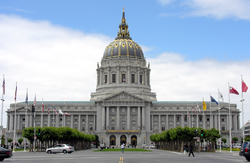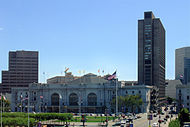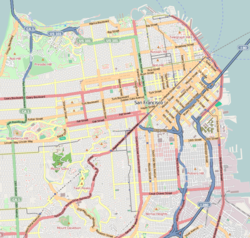- Civic Center, San Francisco
-
San Francisco Civic Center Historic District
 San Francisco City Hall
San Francisco City Hall
on Civic Center plaza, 2003Location: San Francisco, California Coordinates: 37°46′45″N 122°24′57″W / 37.77917°N 122.41583°WCoordinates: 37°46′45″N 122°24′57″W / 37.77917°N 122.41583°W Built: 1912[2] Architectural style: Late 19th and 20th Century revivals
Beaux-ArtsGoverning body: Local NRHP Reference#: 78000757[1] Significant dates Added to NRHP: October 10, 1978 Designated NHLD: February 27, 1987[3] Civic Center
UN Plaza— Neighborhood of San Francisco — San Francisco Civic Center Historic District Graham Auditorium & Fox Plaza. Location within Central San Francisco Coordinates: 37°46′45″N 122°24′57″W / 37.77917°N 122.41583°W Government - Board of Supervisors Jane Kim - State Assembly Tom Ammiano (D) - State Senate Mark Leno (D) - U.S. House Nancy Pelosi (D) Area[4] - Total 1.3 km2 (0.492 sq mi) - Land 1.3 km2 (0.492 sq mi) Population (2008) - Total 10,101 - Density 7,924.7/km2 (20,525/sq mi) [4] ZIP Code 94102, 94109 Area code(s) 415 [4] The Civic Center in San Francisco, California, is an area of a few blocks north of the intersection of Market Street and Van Ness Avenue that contains many of the city's largest government and cultural institutions. It has two large plazas (Civic Center Plaza and United Nations Plaza) and a number of buildings in classical architectural style. The Bill Graham Civic Auditorium (formerly the Exposition Auditorium) is one of the few remaining buildings from the 1915 Panama-Pacific International Exposition.[2] The United Nations Charter was signed in the War Memorial Veterans Building's Herbst Theatre in 1945, leading to the creation of the United Nations. It is also where the 1951 Treaty of San Francisco (the peace treaty that officially ended the Pacific War with the Empire of Japan, which had surrendered in 1945) was signed. The San Francisco Civic Center was designated a National Historic Landmark in 1987.[3]
Contents
Location
The Civic Center is bounded by Market Street on the south, Franklin Street on the west, Turk Street on the north, and Leavenworth and Seventh streets on the east. The Civic Center is bounded by the Tenderloin neighborhood on the north and east and by the Hayes Valley neighborhood on the west; Market Street separates it from the South of Market or "SoMa" neighborhood.
History
The Civic Center was built in the early 20th century as home to a massive City Hall and Hall of Records, both of which were destroyed in the 1906 earthquake. It was planned and rebuilt in its current layout by noted architect and urban planner Daniel Burnham, whose plans for a neo-classical Civic Center was to serve as the centerpiece of a similar theme for the rest of the rebuilt city as part of the "City Beautiful" movement. However, the Civic Center was the only part of his plans actually to be constructed.
The current City Hall and the Exposition Auditorium were completed in 1915, in time for the Panama-Pacific Exposition. The War Memorial Opera House and its neighboring twin, the War Memorial Veterans Building (which together were the nucleus of the San Francisco War Memorial and Performing Arts Center), the Main Library, and the State and Old Federal buildings would be built later, during the 1920s and 1930s.
During World War II, Army barracks and Victory gardens were constructed in the main plaza in front of City Hall and the Library. The 1950s through the 1970s and 1980s saw tall post-modernist Federal and State buildings constructed in the area; an underground exhibition facility, Brooks Hall, was built beneath the Civic Center Plaza in 1958. The Louise M. Davies Symphony Hall and Harold L. Zellerbach Rehearsal Hall were added in 1980. The 1990s saw the construction of a new Main Library with the conversion of the old Main Library building into the Asian Art Museum, and the removal of all public benches. In 1998, the city officially renamed part of the plaza the Joseph L. Alioto Performing Arts Piazza after the former mayor.
Its central location, vast open space, and the collection of government buildings have made and continue to make Civic Center the scene of massive political rallies. It has been the scene of massive anti-war protests and rallies since the Korean War. It was also the scene of major moments of the Gay Rights Movement. Activist Harvey Milk held rallies and gave speeches there. After his assassination on November 27, 1978, a massive candlelight vigil was held there. Later, it was the scene of the White Night Riots in response to the lenient sentencing of Dan White, Milk's assassin. Recently, Civic Center was the center point of the Gay Marriage activism, as Mayor Gavin Newsom married couples there.
Attractions and characteristics
The centerpiece of the Civic Center is the City Hall, which heads the complex and takes up two city blocks on Polk Street. The section of the street in front of the building was renamed Dr. Carlton B. Goodlett, a local African American activist. Across the street on McAllister Street is the headquarters of the Supreme Court of California. Across from that building is the Asian Art Museum, opened in 2004 in the former building of the San Francisco Library which is now in a newer building constructed in 1995.
West of City Hall on Van Ness Avenue is the War Memorial Opera House, where the U.N. Charter was signed in 1945 and the Treaty of San Francisco was signed in 1951. To that building's left is the Davies Symphony Hall, to its right the Herbst Theatre.
North of City Hall is the Phillip Burton Federal Building and United States Courthouse for the United States District Court for the Northern District of California, and State of California office buildings. South of the main Civic Center complex on nearby Mission Street, is the head courthouse of the United States Court of Appeals for the Ninth Circuit which sits across from a newly constructed Federal Building complex.
A monument to James Lick and the Manifest Destiny is located in the middle of Fulton Street between the Library and the Asian Art Museum. The section of Fulton Street between Hyde and Leavenworth Streets has been pedestrianized and re-developed into a monument for the United Nations and the signing of the UN Charter in 1975, when the Bay Area Rapid Transit subway was constructed under Market Street. The 2.6-acre (11,000 m2) pedestrian mall was designed by Lawrence Halprin.[5] It was rededicated in June 1995, by visiting members of the UN General Assembly as part of its 60th anniversary, and renovated and rededicated again in 2005 during the World Environment Day event. Presently, it is the scene of a small farmers' market as well as a large equestrian statue of Simon Bolivar.
Because the Civic Center is located near the skid row Tenderloin neighborhood, Civic Center has a seedy, run-down, high crime reputation and appearance with large amounts of Homeless encampments which has prevented it from attracting the large amounts of tourists seen in other areas of the city. Despite repeated redevelopment of Civic Center over the years aimed primarily at discouraging the homeless from camping there, large amounts of homeless continue to camp and loiter in the area.
Despite such a reputation, its central location also makes it the center of many of the City's festivals and parades. Many of the cities street parades and parties from San Francisco's Gay Pride Parade, to its St. Patrick's Day parade, to San Francisco's version of the Love Parade, the San Francisco LovEvolution party are held at Civic Center.
Civic Center Station is a subway stop for both BART and the Muni Metro. The F Market historic streetcar line and many Muni bus lines run nearby.
The Fox Plaza condominium complex is also located nearby.
In December of 2010, a set of innovative wind and solar hybrid streetlamps provided by Urban Green Energy were installed[6] as part of the center's vision for sustainability.
Educational institutions
Civic Center has three Universities located there; the University of California, Hastings College of the Law, the private The Art Institute of California – San Francisco and The San Francisco Conservatory of Music
Selected photos
-
Earl Warren (old California State) Building with new state building behind
-
James Lick (Pioneer) Monument
-
Civic Center Plaza with San Francisco City Hall in the background, April 2009
See also
References
- ^ "National Register Information System". National Register of Historic Places. National Park Service. 2008-04-15. http://nrhp.focus.nps.gov/natreg/docs/All_Data.html.
- ^ a b NHL Writeup[dead link]
- ^ a b NHL Summary
- ^ a b c [1]
- ^ 2.6 acres, 1975, part of BART construction, Halprin as designer
- ^ Hybrid Street Lamp Hits San Francisco
External links
- Photo tour of Civic Center A photo tour of Civic Center complete with narrative text.
U.S. National Register of Historic Places Topics Lists by states Alabama • Alaska • Arizona • Arkansas • California • Colorado • Connecticut • Delaware • Florida • Georgia • Hawaii • Idaho • Illinois • Indiana • Iowa • Kansas • Kentucky • Louisiana • Maine • Maryland • Massachusetts • Michigan • Minnesota • Mississippi • Missouri • Montana • Nebraska • Nevada • New Hampshire • New Jersey • New Mexico • New York • North Carolina • North Dakota • Ohio • Oklahoma • Oregon • Pennsylvania • Rhode Island • South Carolina • South Dakota • Tennessee • Texas • Utah • Vermont • Virginia • Washington • West Virginia • Wisconsin • WyomingLists by territories Lists by associated states Other  Category:National Register of Historic Places •
Category:National Register of Historic Places •  Portal:National Register of Historic Places
Portal:National Register of Historic PlacesNeighborhoods of San Francisco, California Downtown Chinatown · Civic Center · Financial District · Mid-Market · Nob Hill · North Beach · Mission Bay · South of Market · Telegraph Hill · Tenderloin · Union Square
North of Downtown Cow Hollow · Fisherman's Wharf · Marina District · Pacific Heights · Presidio · Russian Hill · Treasure Island · Yerba Buena Island
Outside Lands Forest Hill · Ingleside · Ingleside Terraces · Ocean View · Parkside · Richmond · Sea Cliff · St. Francis Wood · Sunset District · West Portal · Westwood Highlands · Westwood Park
Western Addition Alamo Square · Anza Vista · Cathedral Hill · Cole Valley · Corona Heights · Duboce Triangle · Fillmore · Haight-Ashbury · Hayes Valley · Japantown · Laurel Heights · Lower Haight · Pacific Heights · Presidio · Western Addition
Southern Bayview-Hunters Point · Bernal Heights · Castro · Crocker-Amazon · Diamond Heights · Dogpatch · Eureka Valley · Excelsior District · Glen Park · Mission District · Noe Valley · Outer Mission · Portola · Potrero Hill · Visitacion Valley
List · Category · Portal Categories:- NRHP articles with dead external links
- Historic districts in California
- American architecture
- Neighborhoods in San Francisco, California
- Landmarks in San Francisco, California
- National Historic Landmarks in the San Francisco Bay Area
- National Register of Historic Places in San Francisco, California
Wikimedia Foundation. 2010.















